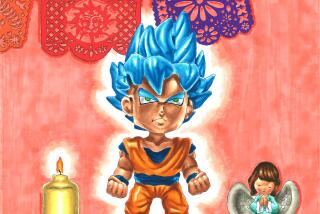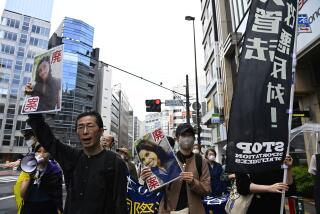A Japan Story: 100 Years of Love : Literature: Lafcadio Hearn, a 19th-Century American newspaperman who fell in love with Japan, is both praised and vilified by readers in his adopted country.
- Share via
MATSUE, Japan — Lafcadio Hearn gazed out his cedar-framed window, contemplated a lotus pond surrounded by irises and moss-covered rocks and listened to the cicadas buzzing on a plum branch.
He turned to his waist-high desk, put pen to paper and wrote a melancholy prophecy that is still valid 100 years after he arrived in this small lakeside city in Izumo, the mythical Province of the Gods.
“Already a multitude of gardens, more spacious and more beautiful than mine, have been converted into rice fields or bamboo groves,” Hearn wrote. “And the quaint Izumo city, touched at last by some long-projected railway line . . . will swell, and change, and grow commonplace, and demand these grounds for the building of factories and mills.
“Not from here alone, but from all the land the ancient peace and the ancient charm seem doomed to pass away. For impermanency is the nature of all things, more particularly in Japan.”
The Greek-Irish journalist from the United States had fallen in love with Japan, although he became increasingly ambivalent as it modernized. And while Hearn has largely slipped into obscurity in the West, the Japanese have never forgotten him, particularly in this centennial year.
Admirers say he was one of the few Westerners who truly understood Japanese culture, possibly because he considered it superior in many ways to the industrialized West.
“He loved the ordinary life, the daily life of the Japanese people,” says Kenji Zenimoto, professor of intercultural studies at Shimane University in Matsue and president of the national Lafcadio Hearn Society.
Elementary school pupils around the country still read Hearn’s Japanese ghost stories, and high-school students practice English with his evocative travel writings. University students study his philosophical essays, and scholars argue passionately over his 12 major books and hundreds of articles and letters.
The largest celebration of his centennial began in Matsue last Aug. 30, exactly 100 years after Hearn arrived, at age 40, to teach English in the city’s middle school.
Hearn wrote about the town in “The Chief City of the Province of the Gods,” part of “Glimpses of an Unfamiliar Japan,” published in 1894.
Here, between a lake and lagoon near the Japan Sea about 390 miles west of Tokyo, one can see that much about Japan has changed and much remains eternal.
Part of Hearn’s garden remains, including the pond and ancient pines. But other houses now encroach upon the northern portion, where wild flowers and grasses once extended to the wooded hills far beyond.
The Lafcadio Hearn Memorial Museum displays Hearn’s desk, the shell he blew when he wanted his pipe lit, his glasses and socks and even a lock of his hair preserved in a stone monument.
There are displays that tell of Hearn’s Japanese wife, their four children, and his teaching posts elsewhere in Japan, including Imperial University in Tokyo.
Next door is the lotus-pond garden and the house where Hearn lived after his romance with Japan turned into marriage. Although he left Matsue in November, 1891, he was to stay in Japan until he died in 1904.
He wed Setsu Koizumi, the daughter of an impoverished samurai family, became a Japanese citizen and a Buddhist and adopted the name by which he is known to most Japanese today: Yakumo Koizumi. Yakumo, which means “eight clouds,” is a poetic version of Izumo.
As a child, Hearn had been virtually abandoned by his Irish father and Greek mother. After working as a reporter in Cincinnati, New Orleans, New York and the West Indies, he thought he had finally found a peaceful home in Old Japan.
But Japan was in the throes of modernization begun in the 1868 Meiji revolution. And just as marriages occasionally succumb to disenchantment, Hearn increasingly found fault with Japan.
Historian Kaoru Sekita, a Hearn scholar at Waseda University in Tokyo, says Hearn predicted that Japan could never successfully adopt some Western ideas, particularly democratic political processes. Hearn thought “the modes of Japanese human relations had not fundamentally changed since mythological times,” Sekita says.
Hearn’s collection of essays, written shortly before he died, also discusses the problems that arise from Japan’s emphasis on group loyalty over individual enterprise. Hearn warned of a “rise of new power” in Japan--an “oligarchy of wealth” that would enslave the people.
Hearn is not universally admired in Japan. Some critics say his romantic portrayal of Old Japan perpetuates the myth that Japan is unique, a misconception they say still keeps Japan from participating fully in the international community. Others condemn his work as a defense of ultra-conservatism.
“Lots of people who love Hearn today are nostalgic about the Old Japan,” says Yuzo Ota, associate professor of history at McGill University in Montreal. “They are modernized intellectuals who like his romanticized picture of Japan. They feel threatened by their own mixed identity.”
Hearn didn’t have a simple love affair with Japan but a complicated love-hate relationship, Ota says.
The accepted view that Hearn loved Japan “is based on suppression of evidence” in Hearn’s letters to friends and other scholars, he says.
Zenimoto says some of Hearn’s letters were cut for publication to remove passages critical of Japan, including some that castigated its rigid bureaucratic, military and educational systems. Also cut were some of Hearn’s wry observations about sex in Japan, which was more open in the late 1800s than it is now, he says.
Zenimoto has written to about 10 U.S. libraries with extensive holdings of Hearn letters in an attempt to compile a definitive collection. He and his assistant, Yuko Kawauchi, also are working on a Hearn catalogue that will list everything written by and about him. So far they have listed 1,900 items and have an estimated 7,000 to go.
Hearn’s 28-year-old great-grandson, Bon Koizumi, curator of the Hearn Memorial Museum, prepared a special collection for the festival. It includes manuscripts, classroom notes of Hearn’s students and English-language textbooks he prepared for his wife and children.
Zenimoto, Ota and Koizumi were among a dozen scholars participating in the five-day festival, which included presentations on Hearn’s newspaper stories on macabre events in Cincinnati, the effect of Hearn’s Irish roots on his work, Hearn’s and other Westerners’ interpretations of Shinto, Japan’s indigenous religion, and Hearn’s ghost stories.
“Lafcadio Hearn was an ideal foreigner to understand Japan, but he also understood cultural shock and the culture gap,” Zenimoto says. “We must understand more minutely his life, but we must not idolize him.”
More to Read
Sign up for our Book Club newsletter
Get the latest news, events and more from the Los Angeles Times Book Club, and help us get L.A. reading and talking.
You may occasionally receive promotional content from the Los Angeles Times.







